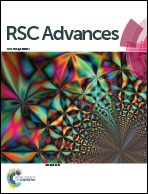Degradation of aquatic sulfadiazine by Fe0/persulfate: kinetics, mechanisms, and degradation pathway†
Abstract
Effects of treatment factors on the kinetics of sulfadiazine (SDZ) removal by Fe0/persulfate (Fe0/PS) were studied at an initial pH of 7.0. The kinetics of SDZ degradation by Fe0/PS were divided into a lag phase and a rapid reaction. The presence of the lag phase was ascribed to the slow release of Fe(II) in the heterogeneous Fe0/PS system. The rapid phase was simulated by pseudo first-order kinetics model. With increasing Fe0 or PS ranging from 0.25 to 2 mM, the kobs (min−1) of SDZ degradation increased and remained stable at a high level of 5 mM Fe0 or PS. But increasing SDZ inhibited the SDZ removal rate for the scavenging of reactive oxygen species (ROS). SDZ degradation by Fe0/PS in neutral or weak alkaline solutions exhibited higher removal rates than in weak acid solutions. Common aquatic materials including sulfate, nitrate, chloride, perchlorate, and HA all showed negative effects on SDZ degradation by Fe0/PS following a trend of Cl− < ClO4− < SO42− < NO3− < HCO3− < HA. The dominating ROS in the Fe0/PS system was identified as ˙SO4− by chemical quenching experiments in the presence of methanol or tert-butyl alcohol. And the chemical detection of dimethyl pyridine N-oxide (DMPO)-˙SO4− and DMPO–˙OH by electron paramagnetic resonance (EPR) spectrum confirmed the presence of ˙SO4−. Besides, strongly negative effects of 1,10-phenanthroline, ethylenediaminetetraacetic acid (EDTA), and dissolving oxygen (DO) on SDZ degradation in the Fe0/PS process proved that ˙SO4− was not generated by an one-step reaction between Fe0 and PS but via the indirect oxidation of Fe(II) by PS. Finally, degradation pathways of SDZ by Fe0/PS were proposed based on theoretical reactive sites attacked by radicals and intermediate products.



 Please wait while we load your content...
Please wait while we load your content...